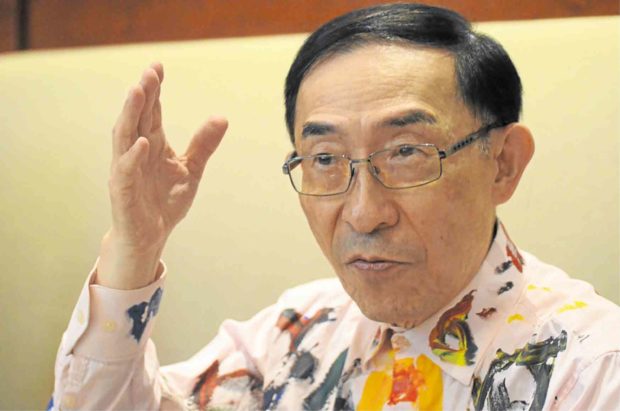
Wearing a tailor-made shirt designed with brushstrokes of acrylic paint is not the most shocking statement Ken Hakuta made when he faced local media in Makati recently.
“Given that he made a career of making art out of television, he never watched television. I would tell him what is going on in television then he’d steal my ideas… and he never gave me credit.”
Hakuta was talking about his uncle, Nam June Paik, the visionary Korean-American artist many consider as the “Father of video art.”
To Hakuta, however, Nam, who passed away in 2006 after suffering a stroke 10 years earlier, is more than that.
“He was a really very good uncle and I think he impacted me in many ways… he wanted me to be open-minded about many things,” said Hakuta, who’s now the executor of the Nam estate.
Hakuta spoke to the media ahead of the exhibition, “Nam June Paik in Manila,” which is presented by León Gallery International in collaboration with Gagosian Gallery.
Hakuta spoke about how when he was a young boy, Nam would drive him crazy by taking him to a lot of museums—which Hakuta hated at the time
—and how his uncle would read publications in as much as seven languages across various topics, including engineering and philosophy.
Classical musician
Although a classical musician trained in Germany, Nam recognized early on the lasting impact consumer technology would have on the sociocultural system, eventually coining the term “electronic superhighway.”
“I guess he found it very new and very exciting,” Hakuta said. “He wanted to try something different. He was just very creative and this was in the 1960s, even before televisions were in every home in the United States.”
Nam, through his friendship with an executive for Sony Corp. at the time, Nobuyuki Idei—who would go on to become president of the Japanese multinational congolomerate—would be one of the first, if not the first, to have a prototype of the Sony Port-a-Pak.
“I believe Mr. Idei wanted Nam to have an early prototype of the Port-a-Pak… My uncle experimented with it in Tokyo and took it with him in New York when he moved there in 1964,” Hakuta writes in the book, “Nam June Paik: Global Visionary” (2012; edited by Hakuta and John Hanhardt).
Hakuta then shared of a legend, a myth, that the first video art/recording in history took place in October 1965 when Paik videotaped the visit of Pope Paul VI to the United Nations in New York.
“He played it for friends at the Café Au Go Go in Greenwich Village and that was kind of the first video performance,” Hakuta says.
Technology as high art
“Nam June Paik in Manila” will exhibit 24 pieces from 1983 to 2005, showcasing Nam’s versatility in various forms of media.
Curated by Jon Huffman and Lisa Nakpil, the show heralds León Gallery International, a subsidiary of León Gallery, as it opens its new home at the ground floor of Corinthian Plaza, 121 Paseo de Roxas in Makati. Gagosian Gallery’s Nick Simunovic is expected to be in attendance.
The design concept came naturally to J. Antonio Mendoza, who immediately saw the potential of turning León Gallery’s new 245 square meters of prime space into a handsome and elegant place.
“I thought of the concept of a bare stretched canvas—matte ultra-white everywhere,” Mendoza said. “The viewer’s eye is immediately drawn to the art and with no other details to foil an almost borderless view. The space was distilled of its web of water pipes, sprinklers, conduits and AC ducts… removing anything visible that would mar the walls like outlets and switches. The result is an unprecedented modern elegance for the first foray of León Gallery International and Gagosian Gallery.”
For León Gallery director Jaime Ponce de León, the trust given to them by Gagosian Gallery, which owns the rights to represent the Nam June Paik artistic estate, is an opportune moment. The auction pioneer said he wants León International to be the force to take Filipino’s appreciation for technology as high art to a different level.
“This is only the second time Gagosian has done something like this in 20 or 25 years,” said Hakuta. “Nam June Paik is one of the most represented artists from Asia in Western museums from the Tate Modern to Moma. It’s really hard to do something like this in Manila and it’s really much to the credit of León Gallery.”
“We are fortunate that here comes the most famous and important gallery in the world, Gagosian, partnering with us,” Ponce de León said, giving credit as well to Hakuta for acting as intermediary between the two entities. “For such a small gallery such as us to be trusted by Gagosian is such a big deal. We are very proud that we have passed their standards… building our name brick by brick has paid off.” —CONTRIBUTED
“Nam June Paik in Manila” will open on Oct. 22 at León Gallery’s newest premises, G/F, Corinthian Plaza, 121 Paseo de Roxas Ave., Makati.